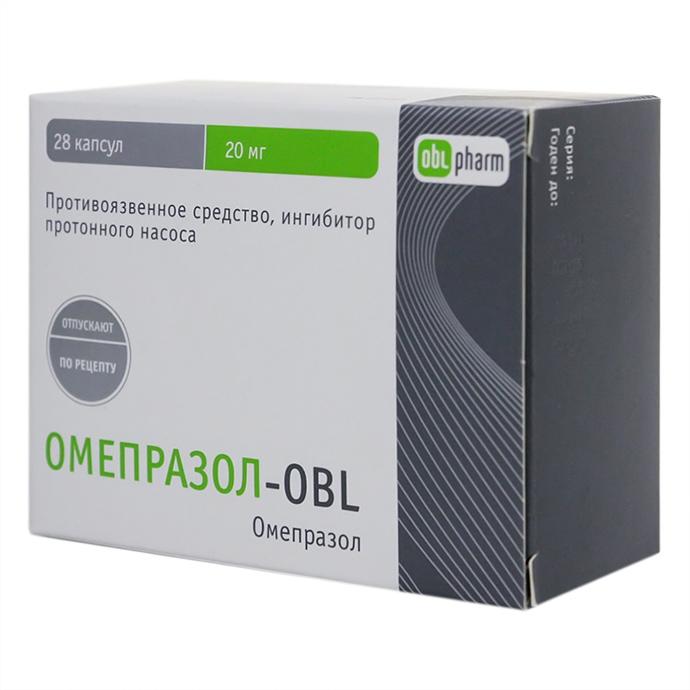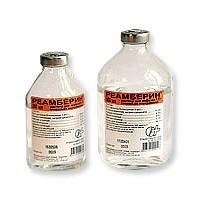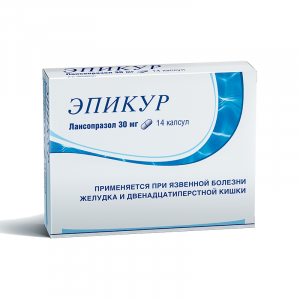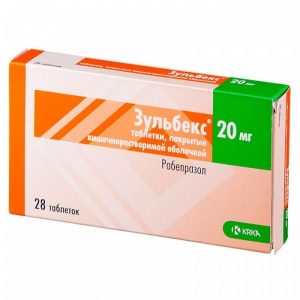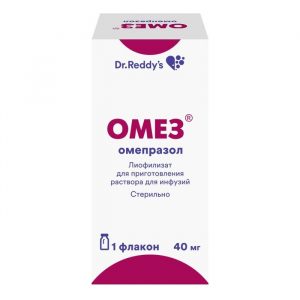Description
Latin name
OMEPRAZOLE
Pharmacological action
Pharmacotherapeutic group:
Anti-ulcer, proton pump inhibitor.
Pharmaceutical action:
Inhibitor of the proton pump, reduces acid production – inhibits the activity of H + / K + -ATPase in the parietal cells of the stomach and thereby blocks the final stage of HCl secretion. The drug is a prodrug and is activated in the acidic environment of the secretory tubules of parietal cells.
Reduces basal and stimulated secretion regardless of the nature of the stimulus. The antisecretory effect after taking 20 mg occurs within the first hour, maximum – after 2 hours.
Inhibition of 50% of the maximum secretion lasts 24 hours. A single dose per day provides quick and effective inhibition of day and night gastric secretion, reaching its maximum after 4 days of treatment and disappearing by the end 3-4 days after the end of the intake. In patients with duodenal ulcer, taking 20 mg of omeprazole maintains an intragastric pH of 3 for 17 hours.
Pharmacokinetics:
Absorption – high, TCmax – 0.5-3.5 hours, bioavailability – 30-40% (with liver failure increases to almost 100%), having high lipophilicity, easily penetrates the parietal cells of the stomach, communication with plasma proteins – 90-95% (albumin and acid alpha1-glycoprotein). T1 / 2 – 0.5 -1 hour (with liver failure – 3 hours), clearance – 500-600 ml / min.
Almost completely metabolized in the liver with the participation of the CYP2C19 enzyme system, with the formation of 6 metabolites (hydroxyomeprazole, sulfide and sulfone derivatives, etc.), pharmacologically inactive.
Is an inhibitor of the CYP2C19 isoenzyme. Excretion by the kidneys (70-80%) and with bile (20-30%). With chronic renal failure, excretion decreases in proportion to a decrease in CC. In elderly patients, excretion decreases, bioavailability increases.
Indications
Peptic ulcer and duodenal ulcer (including relapse prevention), reflux esophagitis, hypersecretory conditions (Zollinger-Ellison syndrome, stress ulcers of the gastrointestinal tract, polyendocrine adenomatosis, systemic mast cell disease) Helicobacter pylori in infected patients with gastric ulcer and duodenal ulcer (as part of combination therapy).
Contraindications
Hypersensitivity, childhood, pregnancy, lactation.
Caution.
Renal and / or liver failure.
Use during pregnancy and lactation
Due to the lack of clinical experience, omeprazole is not recommended for use during pregnancy.
If necessary, use during lactation should decide on the termination of breastfeeding.
Special instructions
Before starting therapy, it is necessary to exclude the presence of a malignant process (especially with gastric ulcer), because treatment, masking symptoms, may delay the correct diagnosis.
Reception at the same time as food does not affect its effectiveness.
Composition
Active ingredient
Omeprazole – 20 mg.
Excipients pellets:
calcium carbonate,
potassium phosphate dibasic
hydroxypropyl methylcellulose (hypromellose)
mannitol
sugar pellets (sucrose)
sugar syrup (sucrose)
polyethylene glycol 6000
polyvinylpyrrolidone K-30
sodium hydroxide
sodium lauryl
talc
titanium
twin 80 dioxide.
Composition of pellet shell:
acrylic coating L30D
Composition of gelatin capsule:
azorubine,
gelatin,
methyl parahydroxybenzonate,
propyl parahydroxybenzoate,
acetic acid.
Dosage and administration
Inside, the capsules are usually taken in the morning, the capsules cannot be chewed
with a little water (just before meals or during meals). In case of exacerbation of peptic ulcer, reflux esophagitis and NSAID gastropathy – 20 mg 1 once a day.
In patients with severe reflux esophagitis, the dose is increased to 40 mg once a day. The course of treatment for peptic ulcer 12 duodenal ulcer – 2-3 weeks, if necessary – 4-5 weeks for gastric ulcer and esophagitis – 4-8 weeks. Patients resistant to treatment with other anti-ulcer drugs are prescribed 40 mg / day . The course of treatment for peptic ulcer of the duodenum is 4 weeks, for peptic ulcer of the stomach and reflux esophagitis – 8 weeks.
With Zollinger-Ellison syndrome – 60 mg, if necessary, increase the dose to 80-120 mg / day (in this case, it is prescribed in 2-3 doses). For the prevention of recurrence of peptic ulcer disease – 10 mg once a day.
To eradicate Helicobacter pylori, triple therapy is used (within 1 week: omeprazole 20 mg, amoxicillin 1 g, clarithromycin 500 mg – 2 times a day, or omeprazole 20 mg, clarithromycin 250 mg, metronidazole 400 mg – 2 times a day or omeprazole 40 mg 1 time per day, amoxicillin 500 mg and metronidazole 400 mg – 3 times a day) or dual therapy (for 2 weeks: omeprazole 20-40 mg and amoxicillin 750 mg – 2 times a day or omeprazole 40 mg – 1 time per day and clarithromycin 500 mg – 3 times a day or amoxicillin 0.75-1.5 g – 2 times a day). Special dosage regimen.
In case of liver failure, 10-20 mg is prescribed in case of impaired renal function and in elderly patients, a dosage regimen correction is not required.
Side effects of the digestive system: diarrhea or constipation, abdominal pain, nausea, vomiting, flatulence in rare cases – increased activity of liver enzymes, taste disturbances in some cases – dry mouth, stomatitis, in patients with a previous serious illness liver – hepatitis (including with jaundice), impaired liver function.
From the hemopoietic organs: in some cases – leukopenia, thrombocytopenia, agranulocytosis, pancytopenia.
From the nervous system: in patients with severe concomitant somatic diseases – dizziness, headache, agitation, depression, in patients with previous severe liver disease – encephalopathy.
From the side of the musculoskeletal system: in some cases – arthralgia, myasthenia gravis, myalgia.
From the skin: rarely – a skin rash and / or itching, in some cases – photosensitivity, erythema multiforme, alopecia.
Allergic reactions: urticaria, angioedema, fever, bronchospasm, interstitial nephritis and anaphylactic shock.
Other: rarely – gynecomastia, malaise, visual impairment, peripheral edema, increased sweating, the formation of gastric glandular cysts during prolonged treatment (due to inhibition of HCl secretion, is benign, reversible).
Overdose.
Symptoms: confusion, blurred vision, drowsiness, dry mouth, headache, nausea, tachycardia, arrhythmia.
Treatment: symptomatic. Hemodialysis is not effective enough.
Drug interactions
May decrease the absorption of ampicillin esters, Fe salts, Itraconazole and ketoconazole (omeprazole increases the pH of the stomach).
Being inhibitors of cytochrome P450, it can increase the concentration and decrease the excretion of diazepam, indirect anticoagulants, phenytoin (drugs that are metabolized in the liver through cytochrome CYP2C19), which in some cases may require a reduction in the doses of these drugs.
At the same time, prolonged use of omeprazole at a dose of 20 mg once a day in combination with caffeine, theophylline, piroxicam, diclofenac, naproxen, metoprolol, propranolol, ethanol, cyclosporine, lidocaine, quinidine and estradiol did not lead to a change in their plasma concentration .
Enhances the inhibitory effect on the hematopoietic system of other drugs. No interactions with simultaneously taken antacids have been observed.
Storage Conditions
List B. Store in a dry, dark place out of the reach of children, at a temperature not exceeding 25oC.
The Expiration of
is 3 years. Do not use after the expiry date stated on the packaging.
Active substance
omeprazole
Conditions conditional release from
pharmacies prescription
lekarstvennaja form
kapsul
Obolensky AF Russian
